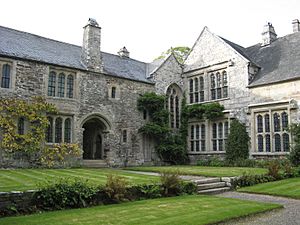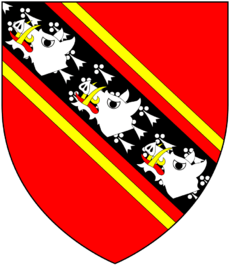Cotehele facts for kids
Quick facts for kids Cotehele |
|
|---|---|

Courtyard of Cotehele House
|
|
| Type | Country house |
| Location | Calstock |
| OS grid reference | SX4224068618 |
| Area | Cornwall |
| Architectural style(s) | Medieval & Tudor |
| Owner | National Trust |
|
Listed Building – Grade I
|
|
| Official name: Cotehele House | |
| Designated | 21 July 1951 |
| Reference no. | 1140255 |
| Official name: Cotehele | |
| Designated | 11 June 1987 |
| Reference no. | 1000648 |
| Lua error in Module:Location_map at line 420: attempt to index field 'wikibase' (a nil value). | |
Cotehele is a beautiful old house in Cornwall, England. It was built a very long time ago, during the Medieval and Tudor periods. This amazing house is made of granite and slate stone. It sits right by the River Tamar.
Cotehele has stayed almost the same for over 500 years. The Edgcumbe family built it in 1485. This happened after their first house was taken down. Sir Richard Edgcumbe received the property. He had fought for Henry Tudor in the Battle of Bosworth. He was given money and the land. Then he started building the Cotehele we see today.
Contents
The History of Cotehele House
The Edgcumbe family got Cotehele when William Edgcumbe married Hilaria. She was the heiress, meaning she inherited Cotehele. This house is one of the best-preserved Tudor houses in the United Kingdom. It still looks much like it did centuries ago.
For many years, Cotehele was a second home for the Edgcumbe family. King George III even visited in 1788. Later, Cotehele was the first property accepted by the government. This was as payment for taxes after someone passed away. Today, the National Trust takes care of the house and its land.
Inside Cotehele, you can see many interesting things. There is a special cupboard called the Cotehele cupboard. There is also a very old clock, known as the Cotehele clock. Many tapestries and pieces of furniture came from Mount Edgcumbe House. Some of these tapestries were cut to fit their new spots.
Exploring Cotehele's Grounds and Gardens
Cotehele House is a very important building. It is a Grade I listed building. This means it has special historical value. The house was likely first built around the year 1300. Some changes were made in the early 1400s. Sir Richard Edgcumbe worked on the house from 1486 to 1489. His son, Sir Piers Edgcumbe, continued the work from 1489 to 1520.
The land around the house goes all the way down to a quay on the River Tamar. A small part of the National Maritime Museum is located there. Cotehele has beautiful formal gardens. There is also a lush area in the valley. You can find a medieval dovecote, which is a home for pigeons. There is also a stewpond, a Victorian summerhouse, and the 18th-century Prospect Tower.
The gardens and parkland are also very special. They are listed as Grade II* on the Register of Parks and Gardens of Special Historic Interest in England. This means they are important historical landscapes. The Morden stream runs along one side of the estate. It flows into the Tamar River at the quay.
The estate also has a mill. This mill used to grind grain. The grain was bought in Plymouth and brought up the river by barge. The mill also powered a sawmill and made electricity. This old mill is now working again. It grinds flour that is used in the restaurant and sold to visitors.
In 2008, a "Mother Orchard" was planted at Cotehele. This orchard has over 250 apple trees. Most of them are types of apples from the West Country. The 8-acre orchard is divided into sections for eating apples, cooking apples, and cider apples.
Cotehele's Chapels
Cotehele has several interesting chapels.
Cotehele House Chapel
Inside Cotehele House, on the west side of Hall Court, you will find a chapel. It is connected to the main house by a small hallway. This chapel is dedicated to St. Katharine and St. Anne. It is one of the oldest rooms in the house, along with the Great Hall. The chapel has a very rare and original clock. This clock still works today and dates back to the Tudor period.
Cotehele Woodland Chapel
In the grounds of Cotehele, near the River Tamar, there is a simple and peaceful chapel. Inside, there are benches along the walls. There are also two benches for ministers and a fancy table. This chapel is dedicated to St George and St Thomas Becket. Sir Richard Edgcumbe (died 1489) built it between 1485 and 1489. He built it to give thanks for escaping from forces loyal to Richard III in 1483.
The Edgcumbe Chapel
The Edgcumbe Chapel is located inside St. Andrew's Church in Calstock. It has two monuments from the late 1600s. These are for Piers Edgcumbe (1666) and for Jemima, Countess of Sandwich (1674). This area is no longer used as a chapel. Ministers now use it to store religious items.
Cotehele as a Film Location
Cotehele has even been used in movies! It was a filming location for Trevor Nunn's 1996 film Twelfth Night. Scenes that took place in a quayside tavern were filmed here. Parts of Orsino's castle were also filmed inside Cotehele.
Gallery
See also
- Mount Edgcumbe House
- Cotehele clock
- List of topics related to Cornwall






